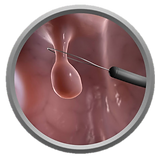Adhesive biomaterial platform
Our fully biodegradable and highly biocompatible adhesive material platform allows us to overcome the challenges associated with commercially-available materials.

Our adhesive material (green) is able to sense tissue surface (red)chemistry and provide optimal adhesion while maintaining the maximal biocompatibility in multiple tissue types and states.
Vascular sealant
Our vascular adhesive consists of a two-component kit that can be sprayed or delivered using a dual-barrel syringe. Its biocompatibility has been tested according to the ISO-10993-5 guidelines, confirming its excellent biocompatibility.
Preclinical porcine studies confirmed the superior performance of our material compared to commercially available sealants. Its synthetic nature affords low cost and safe manufacturing.
Commercial vascular sealant
BioDevek vascular sealant
No recovery 14-day post-surgery
Adequate vessel recovery


The clips display 5-6mm swine carotids 14 days after an ePTFE graft placement. Carotid vessel narrowing owing to blood occlusion during the procedure was significant. BioDevek provided excellent sealing and biocompatibility that was evident by the ability of the vessel to recover to its original dimensions. The commercial sealant that was used as a control did not support vessel recovery as shown by the decreased luminal diameter with a compromised blood flow.
Endoscopic application
We developed a sealant formulation that can be sprayed through catheters during an endoscopic procedure to seal and protect wounds following polyp resection and other minimally-invasive surgeries. Our sealant creates a thin, but tough, tissue-like coating that minimizes the risk of perforation and late-bleeding events.
Colonoscopy screening accompanied by polyp resection, has risen during the last decade as the most efficient method to prevent colorectal cancer, which is the third leading cause of cancer deaths among American men and women. Over 20 million colonoscopies are performed annually in the US.
The use of BioDevek hydrogel on the wound following polyp resection creates a mechanical barrier, reinforcing the integrity of the intestinal wall. Its adhesive nature creates an intimate interdigitation with the tissue, protecting it and avoiding delayed bleeding. The hydrogel shield also acts as a barrier, minimizing the exposure of the wound to the intestinal content, protecting the area from bacteria, enzymes, and mechanical damage, thus enhancing the overall healing process.




Publications
-
G. Muñoz Taboada, P. Dosta, E.R, Edelman, N. Artzi "Sprayable Hydrogel for Instant Sealing of Vascular Anastomosis", Advanced Materials, 2022.
-
S. Unterman, L.F. Charles, S.E. Strecker, D. Kramarenko, D. Pivovarchik, E.R. Edelman, N. Artzi, "Hydrogel Nanocomposites with Independently Tunable Rheology and Mechanics.". ACS Nano, 2017.
-
N. Oliva, M. Carcole, R. Beckerman, A. Hayward, B. Stanley, N. Parry, E.R. Edelman and N. Artzi. "Regulation of dendrimer:dextran material performance by the altered tissue microenvironment in inflammation and neoplasia". Sci Trans Med, 7, 272ra11, 2015. Featured in Science Translational Medicine.
-
N. Artzi & E. Edelman. “Aldehyde-Amine Chemistry Enables Tissue Adhesive Materials to Respond to Physiologic Variation and Pathologic States”, Israel Journal of Chemistry, 53 (9-10), 748-755, 2013.
-
N. Oliva, S. Shitreet, E. Abraham, B. Stanley, E.R. Edelman, N. Artzi. "Natural tissue microenvironmental conditions modulate adhesive material performance". Langmuir, 28(43), 15402-9, 2012.
-
N. Artzi, A. Zeiger, F. Boehning, A. Bon Ramos, K. Van Vliet, E. R. Edelman. “Tuning adhesion failure strength for tissue-specific applications”. Acta Biomater, 7(1), 67-74, 2011. PDF—>N. Artzi, N. Oliva, C. Puron, S. Shitreet, S. Artzi, A. bon Ramos, A. Groothuis, G. Sahagian, E.R. Edelman.
-
"In vivo and in vitro tracking of erosion in biodegradable materials using non-invasive fluorescence imaging". Nature Materials, 10(9), 704-9, 2011.
-
N. Artzi, T. Shazly, A. Baker, A. Bon, and E. Edelman “Aldehyde-Amine Chemistry Enables Modulated Biosealants with Tissue-Specific Adhesion”, Advanced Materials, 21(32- 33), 3399-3403, 2009. Featured in Nature Medicine.